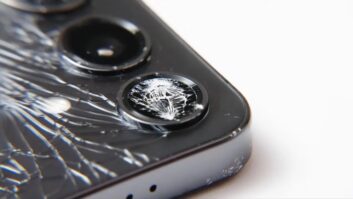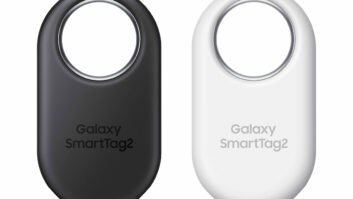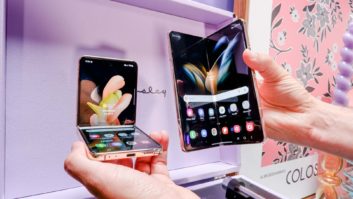New York – Sprint
will be first out of the gate with Samsung’s next-generation Galaxy S II class
Android smartphone on Sept. 16, followed by AT&T and T-Mobile.
Verizon Wireless,
which like its three rivals carried the previous-generation Galaxy S
smartphone, has not announced plans for Samsung’s latest flagship Android
phone.
The S II has been
available outside the U.S. for 85 days, and 5 million have been sold so far,
chief marketing officer Todd Pendleton said last night during a press
conference.
On Sept. 16,
Sprint will make its version, dubbed the Epic 4G Touch, available at $199 with
two-year contract through all of its direct and indirect channels, a
spokesperson told TWICE at Samsung’s press conference. AT&T will follow on
Sept. 19 with its version, a Samsung representative said, although an AT&T
spokesperson declined to confirm the date but said the SII would be available
“later in September.” The AT&T version will feature with 4G HSPA+ 21Mbps
technology, the AT&T spokesperson said.
For its part,
T-Mobile would only say that its version, also expected to feature the 21Mbps
version of 4G HSPA+ technology, would be available sometime in the fall.
The current Galaxy
S on the Sprint network operates on Sprint’s 4G WiMAX network, and T-Mobile’s
version of the Galaxy S operates on that carrier’s 4G HSPA+ 21Mbps network. The
Galaxy S versions for AT&T and Verizon, however, are 3G models.
The S II will be
the thinnest 4G smartphones on the three carriers’ networks, with AT&T’s
version being the thinnest at 8.89mm, while T-Mobile’s version will be 9.49mm
and Sprint’s will be 9.65mm, company representatives said. AT&T’s model,
however, will have the smallest screen of the three at 4.3 inches, whereas the
Sprint and T-Mobile versions will have a 4.52-inch screen.
Key improvements
over the current Galaxy S smartphone include: a 1.2GHz Samsung dual-core
processor, up from their predecessors’ single-core 1GHz processor; the ability
to capture video in 1080p High Profile compared with 720p; and the ability to
output copy-protected movies and TV shows downloaded from Samsung’s Media Hub
service to a TV via HDMI, thanks to the inclusion of HDCP copy-protection
technology. HDCP is already available on Samsung’s Galaxy Tab 10.1 tablet and
soon will be available on the Galaxy Tab 8.9, product planning VP Nick DiCarlo
told TWICE.
Other improvements
include:
— Android 2.3
(Gingerbread) OS, up from 2.1 and 2.2;
— a bigger screen
compared with the original Galaxy’s 4 inches;
— a proprietary
Super AMOLED Plus display compared with Super AMOLED for a higher contrast, brighter
display in daylight;
— the addition of
802.11a to the original model’s 802.11b/g/n as well as Wi-Fi Direct;
— upgraded dual
camera/camcorders, with the rear-facing camera going to 8 megapixels from 5
megapixel, and the front-facing video-chat camera going to 2 megapixels from
VGA;
— speech-to-text
conversion for voice commands;
— Samsung Live
Panel service, which aggregates live web and application content into a single
customizable home screen whose layout can be user-designed and whose online services
and apps can be user-selected;
— Samsung Kies
Air technology to enable a Wi-Fi connection to a PC or Mac without a preloaded
application to synchronize phone content, view and manage such content as
contacts content from the PC, and send SMS messages from the PC;
–Microsoft
Exchange ActiveSync and Sybase remote device management; and
— SSL VPN
support, making it the first Android phone to support the technology, the
company said.
The three devices
also add Mobile High-Definition Link (MHL) technology, which enables the phones
to get power when they stream HD video through the MHL-equipped HDMI ports of
TVs and other home theater equipment, said DiCarlo. MHL also enables the IR
remotes of compatible TVs to control the selection of smartphone-stored video
via an on-TV user interface. The Galaxy S II is offered with optional MicroUSB-to-HDMI
converter cable.
Other features
common to all three versions include front-facing video camera for video chat,
a feature available on the current Galaxy S from T-Mobile and Sprint but
unavailable on AT&T’s current Galaxy S. On the S II, AT&T will enable
video chat only over Wi-Fi, whereas the other carriers are expected to enable
video chat over cellular and Wi-Fi as they did with the Galaxy S.
It also has DLNA
(Digital Living Network Alliance) technology to stream smartphone video to
other DLNA-enabled devices, as well as eight-device mobile Wi-Fi hot spot and
Voice Talk to enable voice commands. All three Galaxy S II devices offer 16GB
of onboard memory as well as a MicroSD card slot that supports up to a 32GB
memory card.













